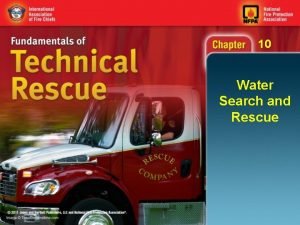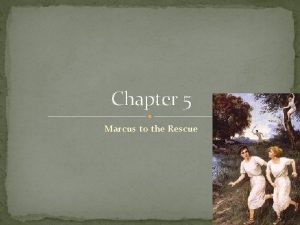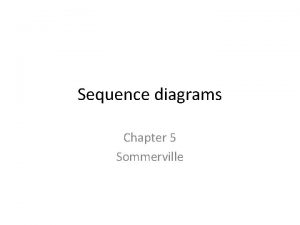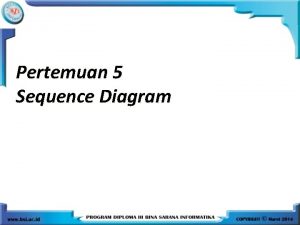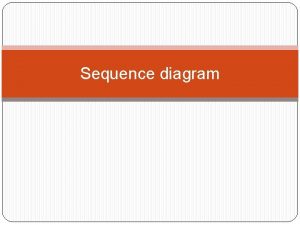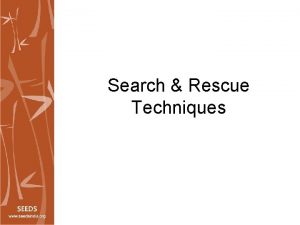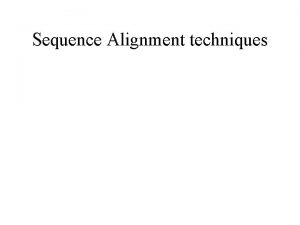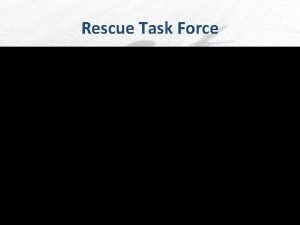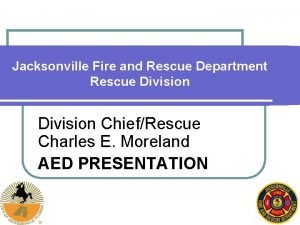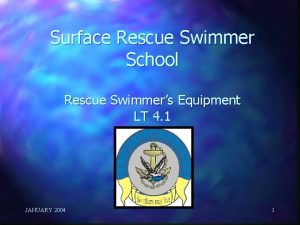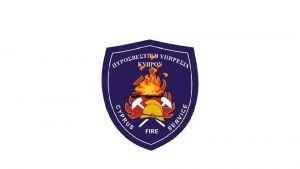Chapter 3 Rescue Techniques The Rescue Sequence 1














































- Slides: 46

Chapter 3 Rescue Techniques “The Rescue Sequence” 1

Enabling Learning Objectives 1. Given a fill-in the blank question, the student will list in order the 5 steps of the rescue sequence according to the class materials. 2. Given a diagram of the movable control point technique, the student will match the line positions according to the class materials. 3. Given a diagram of the tag line rescue technique, the student will label members of the rescue team according to the class materials. 2

Determining the Best Technique n n n SAFETY OF RESCURER is the #1 concern Assess the scene n River hazards and characteristics n Weather Assess the victim n Rescue vs. recovery n Condition n Number of victims Available equipment Available rescue personnel n Number n Skill level 3

Rescue Sequence 1. 2. 3. 4. 5. 6. Self-rescue Shore-based techniques Boat-assisted techniques Boat-based techniques Go rescue Helo 4

Self-Rescue n First step in the rescue sequence n Least dangerous type of rescue n You must determine the ability of the victim to self rescue. n Rescuer must also be able to self rescue themselves. 5

Self-Rescuer n Personal gear n n n n PFD Helmet Wet/dry suit River shoes Neoprene gloves Wicking clothing fleece, wool, etc. . Base layer clothing Knife, Whistle 6

Self-Rescue Position in Current Defensive Swim – float on back with feet up, toes out of water. n Use feet to fend off obstructions. n Use hands to position body 45 degrees to the current in ferrying position. n DO NOT stand up in current. Doing so will risk foot entrapment. 7

Self-Rescue Position in Current Aggressive Swim – strong, forceful crawl stroke on stomach. § Keep body 45 degrees to the current in ferrying position. § Keeping head out of water, aggressively swim to shore or away from hazard. § DO NOT stand up in current. Wait until you get to the shoreline or calm water. § 8

Aggressive Forward Swim 9

Self-Rescue Solid Obstructions n In defensive swim, plant feet high on obstruction and push off and around. n DO NOT let feet slide down or under the surface of the water and risk foot entrapment. Foot Position 10

Self-Rescue Solid Obstructions n If you are in a boat and hit a solid obstruction sideways, LEAN TOWARD the obstruction to prevent capsizing. n If you end up in the water, make sure you position yourself UPSTREAM of your boat. Canoe 11

Self-Rescue Strainers n If you cannot avoid the hazard, aggressively swim at the strainer. n Just before hitting, lunge and pull yourself on top of the strainer using a scissor kick to give upward momentum n DO NOT allow legs or feet to dangle. They may be swept under taking you with them. 12

Self-Rescue Eddies n Eddies Are Your Friend. They provide good resting spots. n To enter, backstroke into eddy OR roll over and swim using crawl stroke. n NO NOT stand up until you can no longer swim and are at shore. 13

Self-Rescue Current n Rotational Capsizing Force- result of crossing a strong current differential, such as when entering or leaving an eddy. n Current acts against the keel and side of the boat n To compensate, operator should lean down-current 14

Self-Rescue Capsized Boats n n Stay upstream of the boat. Aggressive swim toward shore. Remember 45 degree angle. Read downstream river hazards. 15

Self-Rescue Victim n Talk the victim into self-rescue n Give instructions and encouragement n H. E. L. P position n Huddle Position 16

Shore Based Rescues 17

Shore-Based Rescue n n n Second rescue in rescue sequence Rescuer stays safely on shore Rescuer extends an object out to victim and brings them to safety n n n Rope-throw bag PFD Pole, stick Inflated fire hose MARS pole Cargo Net 18

Shore-Based Rescue Throw Bags n Line can be thrown to a victim using throw bags or coils. n Lines can be used to set up stabilization and snag lines for foot entrapments. 19

Shore-Based Rescue Fire Hose Rescue n Hose is rigid and buoyant when filled with air. n Inflated fire hose can be extended to victim. n One fifty foot section can support up to 10 adults. 20

Line Guns Commercially made line guns. n Homemade line guns. n 21

Shore-Based Rescue Vertical Rescues Technician Skill This course will not instruct you in vertical rescues n Used for vertical approaches from objects such as bridge piers and cliffs. n Rescuer is lowered using lower-haul system. All vertical rescuers must be NFPA rope technician level. n 22

Boat-Assisted Rescue Third rescue in rescue sequence n This rescue uses a boat to transport rescuers and gear for positioning but the boat is not used for the actual rescue technique. n Once the persons and gear are set, a shorebased rescue is initiated. n Snag line and Stabilization rescues may be boat assisted depending on river width and access to the far shore. n 23

Boat Assisted Rescue Tag Line This technique is used at a hydraulic, works well in swiftwater to stabilize victim and ferry PFD to stranded victim. n Technique works well if the distance is less than 300 ft wide and there is access to both ends. n Shore line cannot be steep, or densely covered with brush or trees n Rescue may be shore-based if narrow enough to simply throw lines across river. n 24

Boat Assisted Rescue n Two lines (200 -300 ft) are clipped to a flotation device. n Rescuers and one of the attached line bags is taken to the far shore. n Once lines and rescuers are set, the flotation device is pulled into the water along the dam using the two lines. n The device is then worked back and forth across the face of the dam until contact is made with victim. 25

Boat Assisted Rescue Tag Line Face of Dam Victim is Rescued ! V Boil 26

27

28

29 29

30 30

Snag line rescues n n n Similar to tag line rescue. Uses submerged line rather than line above the water. Used to stabilize victim, to un-do a foot entrapment. 31

Boat Based Rescues n Fourth rescue in the rescue sequence n Boat is actually used perform the rescue and makes direct contact with the victim. n Examples include: two boat tether, movable control point and direct pickup of victim, etc… 32

Flip lines 33

Four Line Tether Method § Lines are attached, typically two or four, to move the boat from side to side and up and down on the river. Tenders move dynamically up and down river as needed. § This works best in slower, low cfs water. A minimum of personnel are needed to perform. § This system is quick to set up and utilize. § Highlines may be utilized to effect boat assisted and boat based rescues. Additional tag lines and mechanical advantage lines may be utilized as needed. 34

Two Line Tether 35

How to get victim into boat once rescued Loop step n Blanket Roll n Stirrup step n Double Bounce n Cargo net n Others n 36

Boat Based Rescue High Line System n n n This technique can be used when rescuers must work upstream from a hazard. The boat may utilize its motors to reach the victim rather moves by a line system. A static line is first set up across the river. A system of lines, pulleys, and carabiners are then set up and connected to the static line and boat to move it both side to side and up and down to reach the victim. Control of the lines are maintained by rescuers on one shoreline. 37

High Line System with tether 38

39 39

40 40

Highline 41

42

43

44

45

Review Rescue Sequence 1. 2. 3. 4. 5. 6. Self Rescue Shore Based Boat Assisted Boat Based Go Rescue Helo 46
 Water search and rescue training objectives
Water search and rescue training objectives Nucleotide to amino acid
Nucleotide to amino acid Pseudocode examples
Pseudocode examples Finite series
Finite series Convolutional sequence to sequence learning.
Convolutional sequence to sequence learning. Fonctions techniques
Fonctions techniques Marcus et cornelia in horto ambulant
Marcus et cornelia in horto ambulant Hát kết hợp bộ gõ cơ thể
Hát kết hợp bộ gõ cơ thể Lp html
Lp html Bổ thể
Bổ thể Tỉ lệ cơ thể trẻ em
Tỉ lệ cơ thể trẻ em Voi kéo gỗ như thế nào
Voi kéo gỗ như thế nào Glasgow thang điểm
Glasgow thang điểm Chúa yêu trần thế
Chúa yêu trần thế Môn thể thao bắt đầu bằng chữ f
Môn thể thao bắt đầu bằng chữ f Thế nào là hệ số cao nhất
Thế nào là hệ số cao nhất Các châu lục và đại dương trên thế giới
Các châu lục và đại dương trên thế giới Công thức tiính động năng
Công thức tiính động năng Trời xanh đây là của chúng ta thể thơ
Trời xanh đây là của chúng ta thể thơ Mật thư tọa độ 5x5
Mật thư tọa độ 5x5 Phép trừ bù
Phép trừ bù Phản ứng thế ankan
Phản ứng thế ankan Các châu lục và đại dương trên thế giới
Các châu lục và đại dương trên thế giới Thể thơ truyền thống
Thể thơ truyền thống Quá trình desamine hóa có thể tạo ra
Quá trình desamine hóa có thể tạo ra Một số thể thơ truyền thống
Một số thể thơ truyền thống Cái miệng bé xinh thế chỉ nói điều hay thôi
Cái miệng bé xinh thế chỉ nói điều hay thôi Vẽ hình chiếu vuông góc của vật thể sau
Vẽ hình chiếu vuông góc của vật thể sau Thế nào là sự mỏi cơ
Thế nào là sự mỏi cơ đặc điểm cơ thể của người tối cổ
đặc điểm cơ thể của người tối cổ V. c c
V. c c Vẽ hình chiếu đứng bằng cạnh của vật thể
Vẽ hình chiếu đứng bằng cạnh của vật thể Phối cảnh
Phối cảnh Thẻ vin
Thẻ vin đại từ thay thế
đại từ thay thế điện thế nghỉ
điện thế nghỉ Tư thế ngồi viết
Tư thế ngồi viết Diễn thế sinh thái là
Diễn thế sinh thái là Dạng đột biến một nhiễm là
Dạng đột biến một nhiễm là So nguyen to
So nguyen to Tư thế ngồi viết
Tư thế ngồi viết Lời thề hippocrates
Lời thề hippocrates Thiếu nhi thế giới liên hoan
Thiếu nhi thế giới liên hoan ưu thế lai là gì
ưu thế lai là gì Hổ đẻ mỗi lứa mấy con
Hổ đẻ mỗi lứa mấy con Sự nuôi và dạy con của hổ
Sự nuôi và dạy con của hổ Hệ hô hấp
Hệ hô hấp
